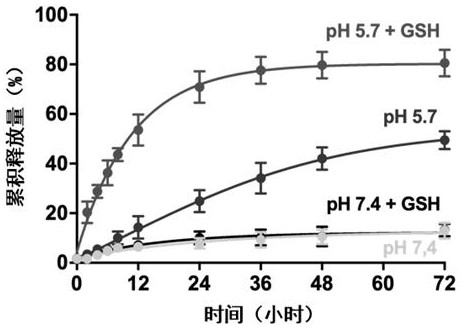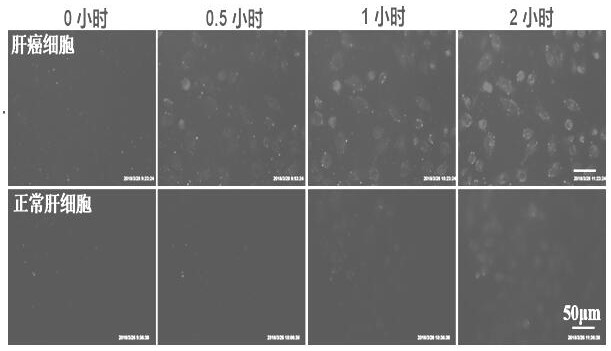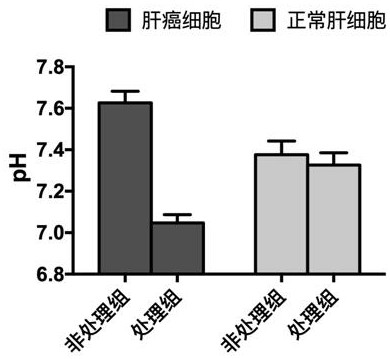Nano-drug delivery system and preparation method of dual-responsive anti-tumor drug loaded for tumor treatment
A technology of anti-tumor drugs and nano-drugs, which is applied in the direction of anti-tumor drugs, drug combinations, drug delivery, etc., can solve the problems of reduced efficacy of doxorubicin, reduced effect of tumor inhibition, weakened efficacy of doxorubicin, etc., to achieve rich The effect of increasing concentration, increasing tumor inhibition rate and avoiding leakage
- Summary
- Abstract
- Description
- Claims
- Application Information
AI Technical Summary
Problems solved by technology
Method used
Image
Examples
Embodiment 1
[0035] Example 1: Preparation of dual-responsive anti-tumor drug-loaded nano-drug delivery carrier for tumor treatment:
[0036] Preparation of oxidized sodium alginate (OSA) by sodium periodate reduction method: Weigh 2 g of sodium alginate (C 5 H 7 O 4 COONa) was dissolved in 120 mL of deionized water, followed by the addition of 20 mL of sodium periodate (NaIO 4 ) solution (n(SA): n(NaIO 4 ) = 1 : 1), add 60 mL of deionized water again. After stirring the reaction in the dark for 24 hours, 0.7 mL of absolute ethanol was added, and the reaction was continued to stir for 30 minutes to terminate the reaction. The resulting crude product was dissolved in 100 mL of deionized water and purified by precipitation with acetone. After 3 times of purification, the crude product was washed with ethanol, and finally OSA was obtained by suction filtration.
[0037] Prepared from ethylenediamine and 11-mercaptoundecanoic acid (C 11 H 22 O 2 S, MUA) coupling to form aliphatic amin...
Embodiment 2
[0044] Example 2: Study on drug release behavior of simulated nanoparticles in vitro:
[0045] The in vitro release profiles of antineoplastic drugs in DSA / CC were investigated in phosphate buffered solutions (pH 7.4 and 5.7) with or without 10 mM GSH. First, 2 mg of DSA / CC was dissolved in 4 mL of buffer solution and transferred to a dialysis bag (MW = 3500 Da), then the dialysis bag was placed in a 50 mL centrifuge tube with release medium at 37 °C. Dialysis. At set time intervals, 0.2 mL samples were withdrawn and replaced with an equal volume of release medium. Finally, the amount of antineoplastic drug released in the samples was determined using an EnspireTM multi-plate reader (excitation 480 nm, emission 588 nm), see figure 1 .
Embodiment 3
[0046] Example 3: Intracellular antitumor drug release monitoring:
[0047] The intracellular release of antitumor drugs was observed by live cell imaging system. Cells (HepG2 and LO2) were divided into 1 x 10 5 Cells / well were seeded to the bottom of a glass dish, 2 mL of 1640 medium (10% fetal bovine serum + 1% penicillin-streptomycin) was added, and the cells were incubated in an incubator (37°C, 5% CO) for 24 hours. 2 ), carefully aspirate the medium, wash twice with PBS, and add 1 mL of DSA / CC-containing medium (25 μg mL -1 )replace. Cells were then incubated in the live cell workstation for 2 hours, set to capture every 10 minutes, see figure 2 .
PUM
| Property | Measurement | Unit |
|---|---|---|
| particle diameter | aaaaa | aaaaa |
Abstract
Description
Claims
Application Information
 Login to View More
Login to View More - R&D
- Intellectual Property
- Life Sciences
- Materials
- Tech Scout
- Unparalleled Data Quality
- Higher Quality Content
- 60% Fewer Hallucinations
Browse by: Latest US Patents, China's latest patents, Technical Efficacy Thesaurus, Application Domain, Technology Topic, Popular Technical Reports.
© 2025 PatSnap. All rights reserved.Legal|Privacy policy|Modern Slavery Act Transparency Statement|Sitemap|About US| Contact US: help@patsnap.com



